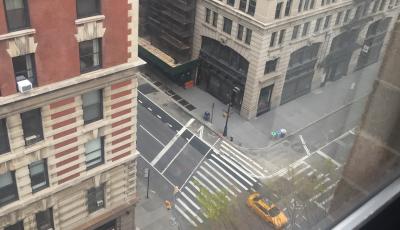New York City’s Criminal Justice Response to COVID-19
Today we launch the first of a series of blog posts by members of the Centre for Criminology about Criminal Justice and other related responses to COVID-19 where they are based. Staff, students, alumni and research associates are scattered around the world, everyone working from home. In sharing photographs from our window, as well as thoughts about the virus, we hope to maintain the close ties that characterise Oxford Criminology, while also sharing insights from around the world.
Recent DPhil Alumna, Dr Rachel Wechsler, who is Acting Assistant Professor of Lawyering at NYU, starts us off, with an account of what is happening in NYC.
Posted:
Time to read:
19 April 2020

I’m writing from lockdown in New York City, the epicentre of coronavirus outbreak in the U.S. NYC has taken a number of criminal justice measures in response to the pandemic. However, many argue that they do not go far enough to prevent infections and stem loss of life due to COVID-19. NYC’s jails, including the notorious Rikers Island jail, had 364 confirmed cases as of 17 April, comprising 9 percent of the inmate population (for comparison purposes, the overall NYC infection rate on that same day was 1.49 percent). While more than 1400 individuals have been released from NYC’s jails over the course of the past month, advocates have decried a lack of speed and transparency in the release process. On 3 April, the New York Civil Liberties Union and The Legal Aid Society filed a class action lawsuit challenging the automatic detention of individuals awaiting adjudication of their alleged parole violations, emphasizing the virus’s rapid spread in NYC’s jails and the suspension of almost all parole revocation hearings, which would have provided many detained individuals with the opportunity for release, due to the pandemic. The Independent Commission on New York City Criminal Justice and Incarceration Reform, chaired by former New York State Chief Judge Jonathan Lippman, issued a report on 17 April containing “three urgent recommendations for NYC” in light of the pandemic: (1) immediately lift all warrants for individuals accused of parole violations; (2) expedite the release of pretrial detainees at heightened risk from COVID-19 due to age and/or underlying medical conditions; and (3) fully comply with the U.S. Centers for Disease Control and Prevention’s health and safety guidelines for correctional and detention facilities. These recommendations are aimed at decreasing the population density within NYC’s jails, protecting the most vulnerable incarcerated individuals, and lowering the risk of the virus’s spread among inmates, staff, and visitors. The Correction Officers’ Benevolent Association (labour union) sued the NYC Department of Corrections on 2 April over a lack of personal protective equipment (PPE), coronavirus testing sites, and other protection measures for corrections officers working in the city’s jails. The lawsuit was settled last Wednesday.

Similarly, the New York City Police Benevolent Association filed a complaint with the New York State Public Employee Safety & Health Bureau on 9 March alleging that the New York City Police Department (NYPD) had violated federal law in failing to provide police officers with adequate PPE and training on proper COVID-19 prevention and responses. As of 16 April, approximately 4200 NYPD employees had tested positive for coronavirus and 27 had died. The NYPD currently has a pilot program for checking officers’ temperatures before they begin their shifts at eight of the busiest precincts, which it plans to expand to all other precincts by 24 April.

The risks posed by COVID-19 are exacerbated in the criminal justice context, particularly within the confines of a densely-populated urban environment. Given the highly contagious nature of the virus, responses in the criminal justice sphere (and elsewhere) must be implemented as a matter of urgency. Hopefully lessons can be learned from the situation in NYC and more proactive, rather than reactive, policies and measures can be established to ready cities for future challenges.
The images shown are taken from my windows.
Share:
